Physical Address
304 North Cardinal St.
Dorchester Center, MA 02124
Physical Address
304 North Cardinal St.
Dorchester Center, MA 02124
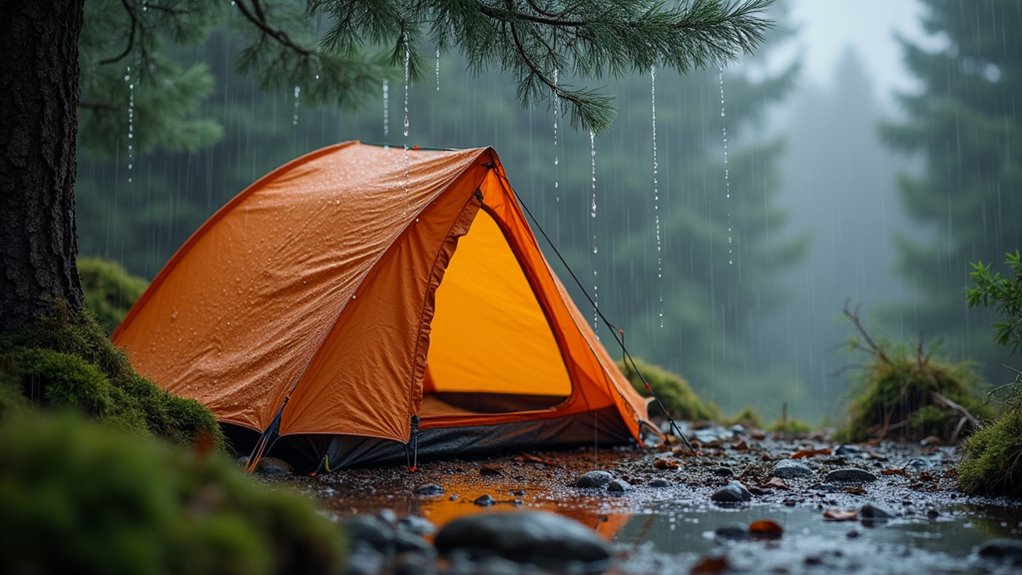
Learn essential rain camping techniques that transform soggy disasters into comfortable adventures—discover the secrets most backpackers wish they knew sooner.
You’ve packed your gear, checked the forecast, and hit the trail—only to watch dark clouds roll in faster than expected. Rain doesn’t have to ruin your backcountry adventure if you’re prepared with the right techniques and mindset. Most camping mishaps in wet weather stem from poor site selection and inadequate moisture management, both of which you can master without breaking the bank. The difference between a miserable night and a memorable experience often comes down to knowing these critical strategies.
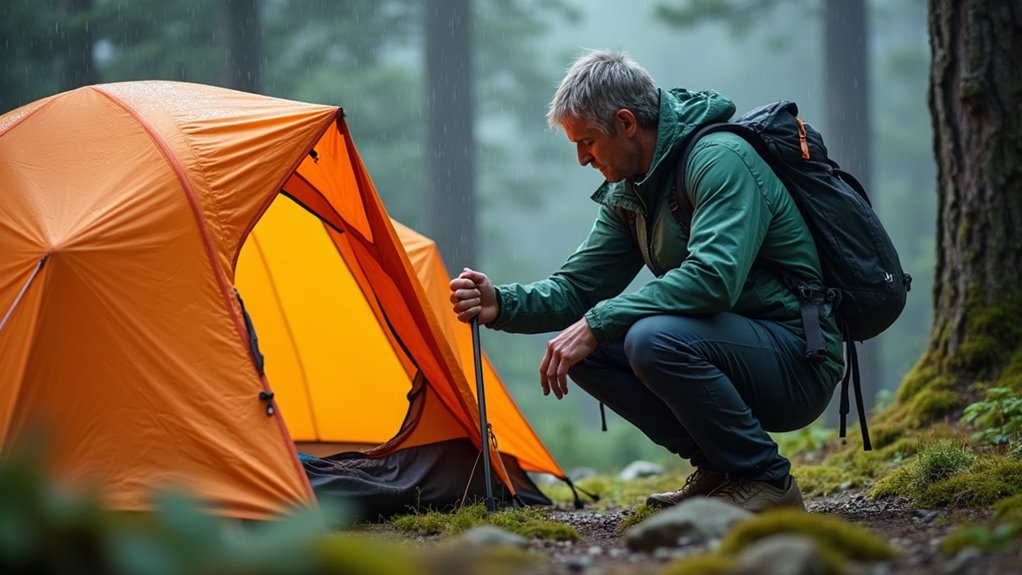
When rain clouds gather over your backcountry campsite, having the right gear can mean the difference between a memorable adventure and a miserable slog back to the trailhead.
Your waterproof shell jacket should breathe well and pack small—don’t overspend on fancy brands when budget options perform similarly. Pair it with lightweight rain pants that won’t restrict movement.
Budget rain gear that breathes and packs light beats expensive brands—focus on function over flashy logos when choosing your backcountry weather protection.
A quality pack cover costs less than replacing soaked gear, though a contractor-grade trash bag works in a pinch.
Waterproof your tent’s seams before departing, and pack extra guy-lines for stormy conditions.
Quick-dry clothing underneath keeps you comfortable when moisture inevitably sneaks in. Skip cotton entirely—synthetic materials and merino wool maintain warmth when wet.
A simple tarp adds versatility for cooking areas or emergency shelter without breaking your budget.
If heavy rains create swollen waterways on your route, knowing how to safely cross a river becomes crucial for getting back to civilization without putting yourself at risk.
Although proper gear matters, your campsite selection becomes even more critical when storms threaten. You’ll want to avoid low-lying areas where water naturally collects – valleys, depressions, and creek beds become temporary rivers during heavy rainfall.
Look for slightly elevated ground with natural drainage. A gentle slope helps water run off without creating erosion under your tent. Check overhead for dead branches or unstable trees that could fall during wind gusts.
Position your tent’s entrance away from prevailing winds, and use natural windbreaks like boulders or dense vegetation. Don’t camp directly under large trees – they’re lightning magnets and drop cold water long after rain stops.
Scout for firm ground that won’t turn muddy. Sandy or rocky soil drains better than clay, keeping your campsite manageable throughout the storm. Keeping your tent dry is especially crucial in cold weather conditions where moisture management becomes a critical safety factor.
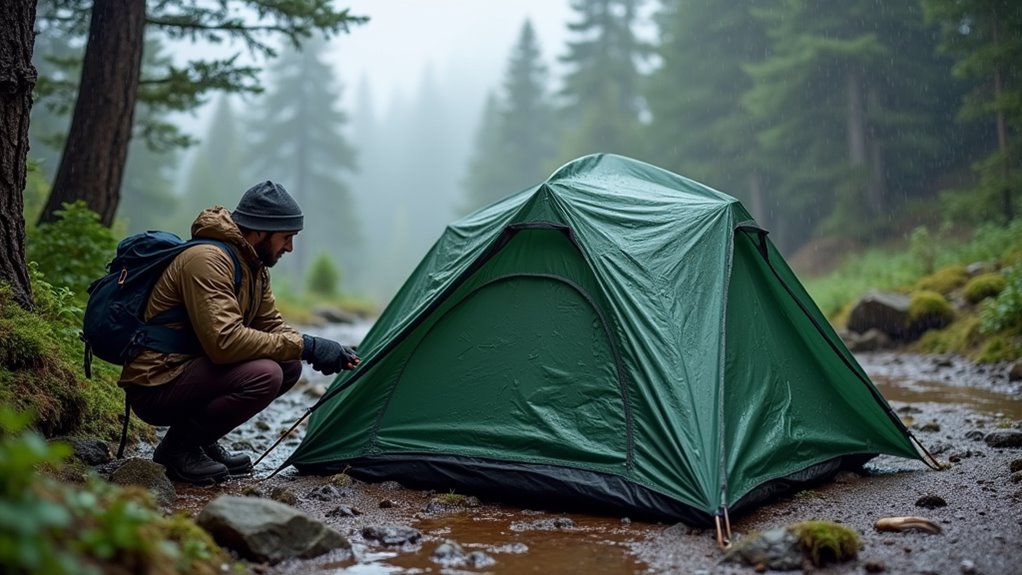
Once you’ve found the perfect spot, your tent setup determines whether you’ll stay dry or spend the night in a soggy mess. First, lay down your footprint or tarp—it’s cheaper than replacing your tent floor. Make sure it doesn’t extend beyond your tent’s edges, or it’ll funnel water underneath.
Stake out your rainfly tight and low. Saggy flies collect water and eventually leak. Don’t skip the guylines—they’re your tent’s backbone in wind and rain. Angle stakes away from the tent at 45 degrees for maximum holding power.
Create a small drainage ditch around your tent’s perimeter if water starts pooling.
Keep your vestibule organized for quick gear access without letting rain inside. Test your zippers before the storm hits.
Even with perfect tent setup, moisture finds its way inside through condensation, wet gear, and your own breathing. You’ll need a strategic approach to stay comfortable.
Keep wet clothes and gear in your tent’s vestibule, not inside your sleeping area. If you don’t have a vestibule, use a plastic bag or stuff sack to contain damp items. Place a small towel near the entrance for quick wipe-downs.
Crack your tent’s vents slightly, even in rain. This reduces condensation buildup from your breath and body heat. The trade-off of minimal moisture entry beats sleeping in a humid sauna.
Pack an extra set of dry base layers and socks in a waterproof bag. Change into these before sleeping, then change back to damp clothes in the morning.
A reliable camping lantern provides essential illumination for nighttime gear organization and helps you safely navigate your shelter during wet weather conditions.
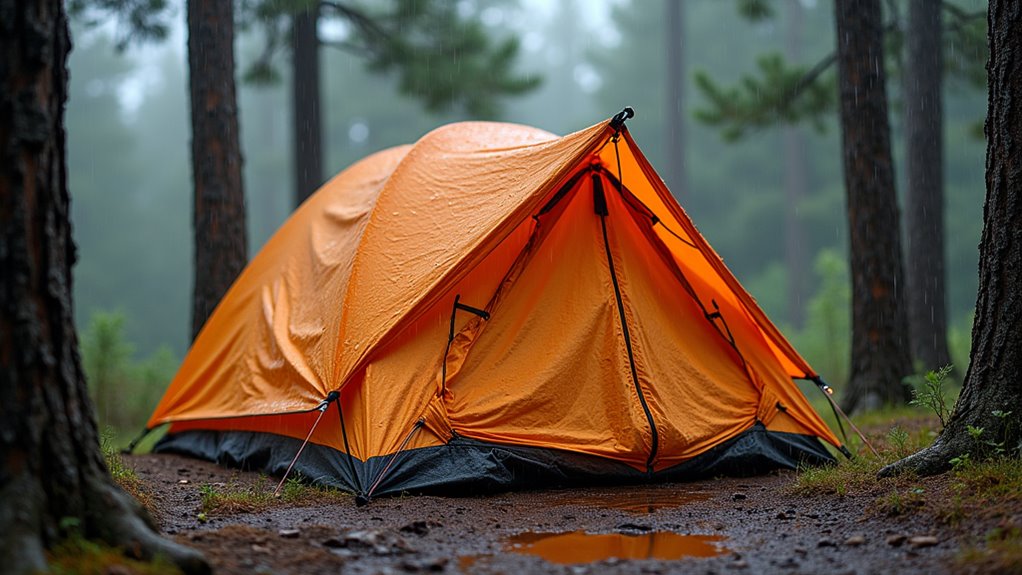
Beyond keeping your sleeping area dry, you’ll face an ongoing battle against moisture that builds up naturally inside your tent. Your breath and body heat create condensation that’ll soak your gear if left unchecked.
Crack your tent’s vents and rainfly openings slightly to promote airflow, even during rain. This ventilation lets humid air escape while preventing major water intrusion. Keep wet gear in your vestibule rather than inside your sleeping area.
Wipe down tent walls with a bandana or small towel when condensation forms. Pack extra socks and underwear in waterproof stuff sacks – they’re your priority dry items. A small pack towel costs under ten dollars and pays dividends for managing moisture throughout your trip.
Just like deciding whether to rent or buy camping gear, consider borrowing or purchasing a high-quality dehumidifier packet for extended wet weather trips.
When rain starts falling, your cooking routine needs a complete overhaul to keep your stove, food, and gear dry. You’ll need to find or create adequate shelter for cooking operations.
Set up under your tarp’s extended edge or use your tent’s vestibule if it’s large enough. Keep your stove on stable, level ground and shield it from wind and moisture. A lightweight windscreen works wonders for efficiency.
A proper cooking shelter and windscreen setup can make the difference between a hot meal and a soggy mess.
Smart food storage becomes critical when everything’s wet:
Cook quickly and pack everything away immediately to prevent soggy disasters. Having the right campfire cooking tools can make meal preparation much more manageable even in challenging wet conditions.
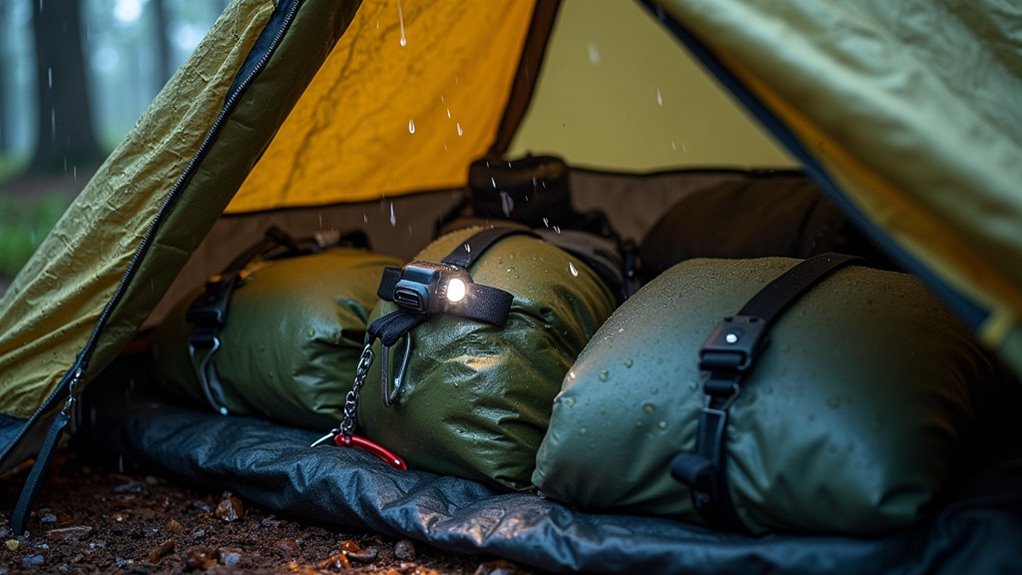
Rain doesn’t just threaten your cooking setup—it can turn your entire gear collection into a soggy, disorganized mess if you’re not prepared. Start by grouping similar items in clear plastic bags or dry sacks. You’ll quickly find what you need without dumping everything out. Keep frequently used items in easily accessible pockets of your pack.
Create a designated “wet gear” area outside your tent using a tarp or pack cover. This prevents soaked clothes and boots from contaminating dry items inside. Pack extra garbage bags—they’re cheap insurance for protecting electronics, spare clothes, and sleeping gear.
Always pack your sleeping bag and extra clothes in waterproof stuff sacks first, then place them inside your pack. If water gets in, these critical items stay dry.
These organization strategies become even more crucial for first-time campers who may not yet have developed efficient packing routines.
Starting a fire in wet conditions feels impossible until you master a few key techniques that work even when everything’s soaked.
Look for dry tinder inside dead branches, under rock overhangs, or in your emergency kit. You’ll need three times more kindling than usual since wet wood burns slower. Build your fire on a platform of rocks or green logs to keep it off soggy ground.
Essential wet-weather fire techniques:
You’ll appreciate having backup fire starters like waterproof matches and chemical fire cubes. Once your fire is established, focus on camping cooking techniques that work well over an open flame in challenging weather conditions.
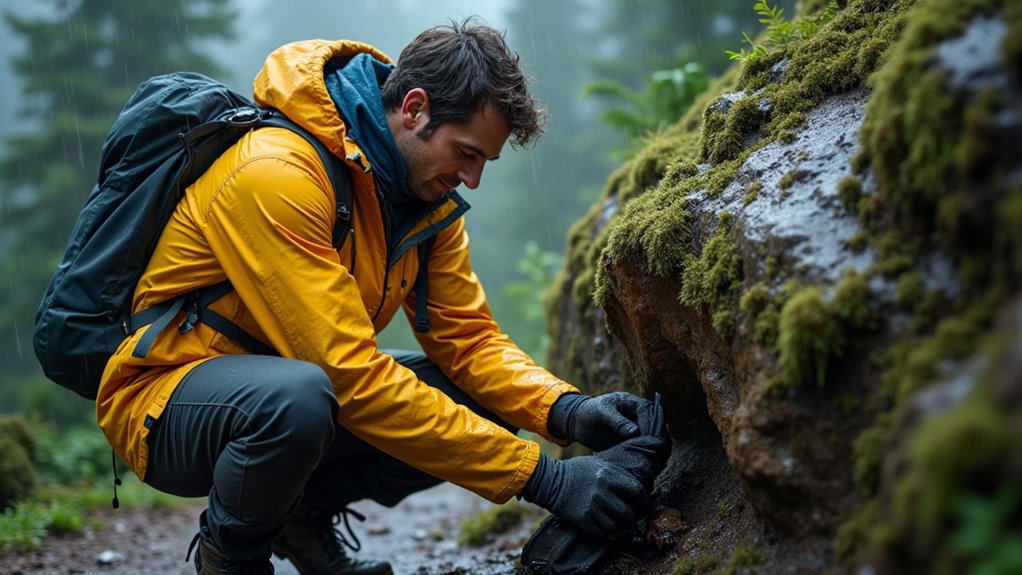
While staying dry seems like the obvious goal, successful rain camping actually depends on managing moisture rather than avoiding it completely. You’ll sweat inside waterproof gear, so focus on layering systems that breathe and dry quickly.
Start with merino wool or synthetic base layers—never cotton. These materials wick moisture and retain warmth when wet. Add an insulating mid-layer like fleece or down that you can remove before you overheat.
Cotton kills in wet conditions—stick with merino wool or synthetics that work even when soaked.
Your outer shell should be waterproof but breathable. Pit zips and ventilation panels help dump excess heat.
Pack extra socks and underwear in waterproof bags—dry feet prevent blisters and maintain morale.
Keep one complete dry outfit sealed away for sleeping. This backup system guarantees you’ll have warm, dry clothes when temperatures drop overnight.
Remember that family camping often means helping kids stay comfortable and positive when conditions turn challenging, so having reliable gear systems becomes even more critical.
When lightning threatens your campsite, you’ll need to make quick decisions that could save your life. Don’t wait for the storm to intensify—act immediately when you hear thunder or see distant flashes.
Your lightning safety priorities should include:
Flash floods pose another serious threat during heavy rain. Never camp in washes, creek beds, or low-lying areas where water naturally flows, even if they appear dry.
Consider utilizing share economy platforms to access weather monitoring equipment or emergency communication devices that other campers in your area might be willing to rent out during severe weather conditions.
You’ve now got the roadmap to turn a soggy situation into a comfortable adventure. Rain doesn’t have to dampen your backcountry spirits—it’s just another challenge to conquer with the right know-how. Pack smart, pitch wisely, and stay organized like your comfort depends on it. Remember, every drop that falls is a chance to prove you’re tougher than the weather. Get out there and show Mother Nature you’re ready for whatever she throws your way.